本文實(shí)例為大家分享了iOS主題皮膚切換代碼,供大家參考,具體內(nèi)容如下
1. 主題皮膚功能切換介紹
主題切換就是根據(jù)用戶設(shè)置不同的主題,來(lái)動(dòng)態(tài)改變用戶的界面,通常會(huì)改變navigationBar背景圖片、tabBar背景圖片、tabBar中的按鈕的圖片和選中的背景圖片、navigationItem.title 標(biāo)題的字體顏色、UI中其他元素控件
2.項(xiàng)目目錄結(jié)構(gòu)及實(shí)現(xiàn)效果截圖
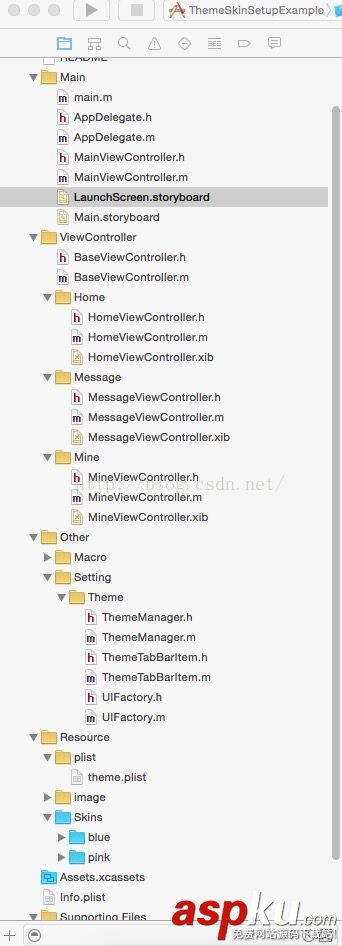
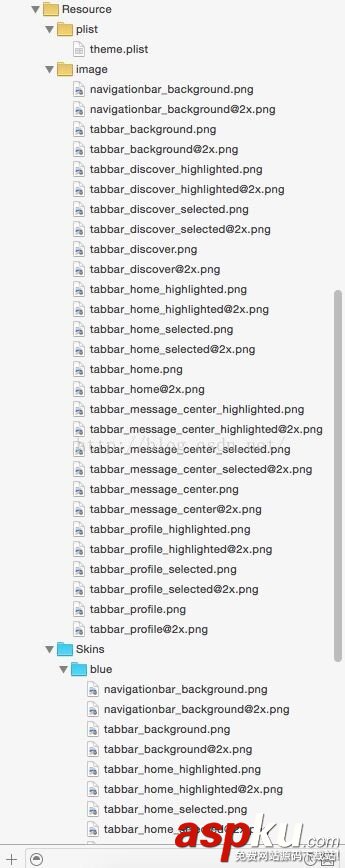

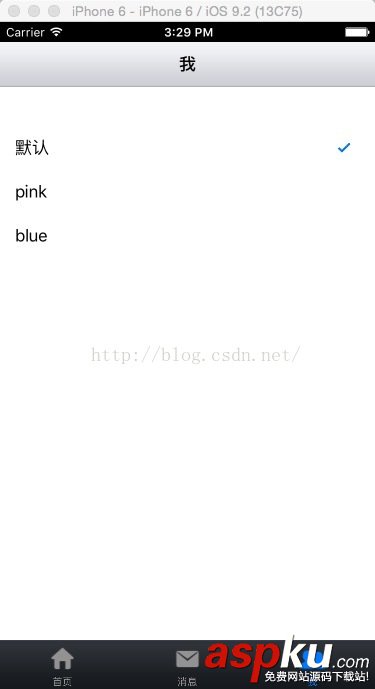
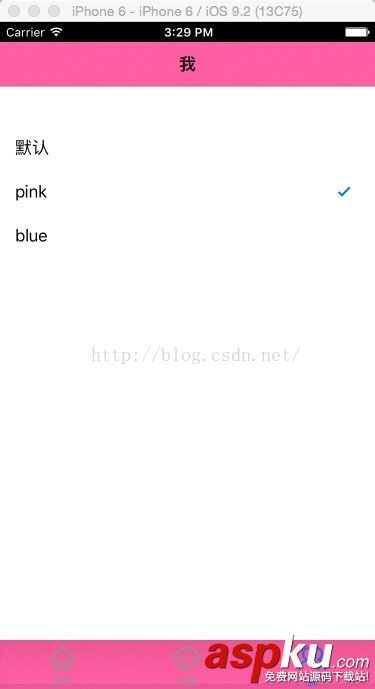
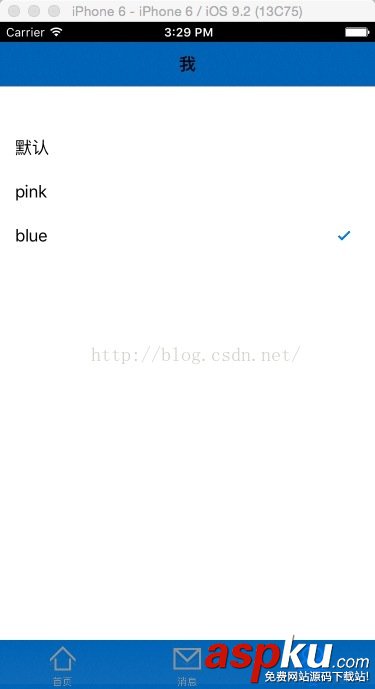
3. 具體實(shí)現(xiàn)步驟
1.將image文件夾(group)和 Skins拖入到項(xiàng)目工程中的資源文件夾中
2.創(chuàng)建BaseViewController
3.配置theme.plist
4.事項(xiàng)項(xiàng)目所需的基本框架供能,并實(shí)現(xiàn)主題的tableView功能
5.創(chuàng)建主題管理器:ThemeManager
6.自定義ThemeTabBarItem 控件
7.創(chuàng)建UI工廠: UIFactory
8. 實(shí)現(xiàn)tableView中的didSelected事件完成主題切換
9.記錄用戶選擇的主題,以便用戶下次啟動(dòng)時(shí)是上次設(shè)置的主題
1.創(chuàng)建BaseViewController
#import <UIKit/UIKit.h> @interface BaseViewController : UIViewController - (void) reloadThemeImage; @end
#import "BaseViewController.h" #import "ThemeManager.h" #import "NotificationMacro.h" @interface BaseViewController () @end @implementation BaseViewController - (id) init { if (self == [super init]) { [[NSNotificationCenter defaultCenter] addObserver:self selector:@selector(themeChangedNotfication:) name:kThemeChangedNotification object:nil]; } [self reloadThemeImage]; return self; } - (void)viewDidLoad { [super viewDidLoad]; [self reloadThemeImage]; } - (void)didReceiveMemoryWarning { [super didReceiveMemoryWarning]; // Dispose of any resources that can be recreated. } - (void) themeChangedNotfication:(NSNotification *)notification { [self reloadThemeImage]; } - (void) reloadThemeImage { ThemeManager * themeManager = [ThemeManager sharedThemeManager]; UIImage * navigationBackgroundImage = [themeManager themeImageWithName:@"navigationbar_background.png"]; [self.navigationController.navigationBar setBackgroundImage:navigationBackgroundImage forBarMetrics:UIBarMetricsDefault]; UIImage * tabBarBackgroundImage = [themeManager themeImageWithName:@"tabbar_background.png"]; [self.tabBarController.tabBar setBackgroundImage:tabBarBackgroundImage]; } @end 2. 實(shí)現(xiàn)AppDelegate
#import "AppDelegate.h" #import "MainViewController.h" #import "ThemeManager.h" #import "NotificationMacro.h" @interface AppDelegate () @end @implementation AppDelegate - (BOOL)application:(UIApplication *)application didFinishLaunchingWithOptions:(NSDictionary *)launchOptions { [self initUserDefaultConfig]; MainViewController * rootViewController = [[MainViewController alloc] init]; self.window.rootViewController = rootViewController; return YES; } - (void) initUserDefaultConfig { NSString * themeName = [[NSUserDefaults standardUserDefaults] objectForKey:kThemeNameKey]; ThemeManager * themeManager = [ThemeManager sharedThemeManager]; themeManager.themeName = themeName; }</span></span>
<span style="font-weight: normal;"><span style="font-weight: normal;">#import "MainViewController.h" #import "HomeViewController.h" #import "MessageViewController.h" #import "MineViewController.h" #import "UIFactory.h" @interface MainViewController () @end @implementation MainViewController - (id) init { if (self = [super init]) { [self initTabBarUI]; } return self; } - (void)viewDidLoad { [super viewDidLoad]; } - (void)didReceiveMemoryWarning { [super didReceiveMemoryWarning]; } - (void) initTabBarUI { // 主頁(yè) HomeViewController * homeViewController = [[HomeViewController alloc] init]; UINavigationController * homeNavigationController = [[UINavigationController alloc] initWithRootViewController:homeViewController]; // UITabBarItem * homeTabBarItem = [[UITabBarItem alloc] initWithTitle:@"主頁(yè)" image:[UIImage imageNamed:@"tabbar_home"] selectedImage:[UIImage imageNamed:@"tabbar_home_selected"]]; UITabBarItem * homeTabBarItem = [UIFactory createTabBarItemWithTitle:@"主頁(yè)" imageName:@"tabbar_home" selectedImage:@"tabbar_home_selected"]; homeNavigationController.tabBarItem = homeTabBarItem; // 消息(中心) MessageViewController * messageViewController = [[MessageViewController alloc] init]; UINavigationController * messageNavigationController = [[UINavigationController alloc] initWithRootViewController:messageViewController]; // UITabBarItem * messageTabBarItem = [[UITabBarItem alloc] initWithTitle:@"消息" image:[UIImage imageNamed:@"tabbar_message_center"] selectedImage:[UIImage imageNamed:@"tabbar_message_center_selected"]]; UITabBarItem * messageTabBarItem = [UIFactory createTabBarItemWithTitle:@"消息" imageName:@"tabbar_message_center" selectedImage:@"tabbar_message_center_selected"]; messageNavigationController.tabBarItem = messageTabBarItem; // 我 MineViewController * mineViewController = [[MineViewController alloc] init]; UINavigationController * mineNavigationController = [[UINavigationController alloc] initWithRootViewController:mineViewController]; // UITabBarItem * mineTabBarItem = [[UITabBarItem alloc] initWithTitle:@"我" image:[UIImage imageNamed:@"tabbar_profile"] selectedImage:[UIImage imageNamed:@"tabbar_profile_selected"]]; UITabBarItem * mineTabBarItem = [UIFactory createTabBarItemWithTitle:@"我" imageName:@"tabbar_profile" selectedImage:@"tabbar_profile_selected"]; mineNavigationController.tabBarItem = mineTabBarItem; NSArray * viewControllers = @[homeNavigationController, messageNavigationController, mineNavigationController]; self.viewControllers = viewControllers; } @end 3. 創(chuàng)建主題管理器
#import <Foundation/Foundation.h> #import <UIKit/UIKit.h> @interface ThemeManager : NSObject @property (nonatomic, copy) NSString * themeName; // 主題名字 @property (nonatomic, retain) NSDictionary * themePlistDict; // 主題屬性列表字典 + (ThemeManager *) sharedThemeManager; - (UIImage *) themeImageWithName:(NSString *)imageName; @end</span></span>
<span style="font-weight: normal;"><span style="font-weight: normal;">#import <Foundation/Foundation.h> #import <UIKit/UIKit.h> @interface ThemeManager : NSObject @property (nonatomic, copy) NSString * themeName; // 主題名字 @property (nonatomic, retain) NSDictionary * themePlistDict; // 主題屬性列表字典 + (ThemeManager *) sharedThemeManager; - (UIImage *) themeImageWithName:(NSString *)imageName; @end #import "ThemeManager.h" #import "NotificationMacro.h" static ThemeManager * sharedThemeManager; @implementation ThemeManager - (id) init { if(self = [super init]) { NSString * themePath = [[NSBundle mainBundle] pathForResource:@"theme" ofType:@"plist"]; self.themePlistDict = [NSDictionary dictionaryWithContentsOfFile:themePath]; self.themeName = nil; } return self; } + (ThemeManager *) sharedThemeManager { @synchronized(self) { if (nil == sharedThemeManager) { sharedThemeManager = [[ThemeManager alloc] init]; } } return sharedThemeManager; } // Override 重寫(xiě)themeName的set方法 - (void) setThemeName:(NSString *)themeName { _themeName = themeName; } - (UIImage *) themeImageWithName:(NSString *)imageName { if (imageName == nil) { return nil; } NSString * themePath = [self themePath]; NSString * themeImagePath = [themePath stringByAppendingPathComponent:imageName]; UIImage * themeImage = [UIImage imageWithContentsOfFile:themeImagePath]; return themeImage; } // 返回主題路徑 - (NSString *)themePath { NSString * resourcePath = [[NSBundle mainBundle] resourcePath]; if (self.themeName == nil || [self.themeName isEqualToString:@""]) { return resourcePath; } NSString * themeSubPath = [self.themePlistDict objectForKey:self.themeName]; // Skins/blue NSString * themeFilePath = [resourcePath stringByAppendingPathComponent:themeSubPath]; // .../Skins/blue return themeFilePath; } @end 4. 創(chuàng)建主題按鈕 ThemeTabBarItem
#import <UIKit/UIKit.h> @interface ThemeTabBarItem : UITabBarItem @property (nonatomic, copy) NSString * imageName; @property (nonatomic, copy) NSString * selectedImageName; - (id) initWithTitle:(NSString *)title imageName:(NSString *)imageName selectedImage:(NSString *)selectedImageName; @end </span></span>
<span style="font-weight: normal;"><span style="font-weight: normal;">#import "ThemeTabBarItem.h" #import "ThemeManager.h" #import "NotificationMacro.h" @implementation ThemeTabBarItem // 初始化時(shí)注冊(cè)觀察者 - (id) init { if (self = [super init]) { [[NSNotificationCenter defaultCenter] addObserver:self selector:@selector(themeChangedNotification:) name:kThemeChangedNotification object:nil]; } return self; } - (id) initWithTitle:(NSString *)title imageName:(NSString *)imageName selectedImage:(NSString *)selectedImageName { if (self = [self init]) { self.title = title; self.imageName = imageName; // 此時(shí)會(huì)調(diào)用[self setImageName:imageName] ---> [self reloadThemeImage] --->[self setImage:image] self.selectedImageName = selectedImageName;// 此時(shí)會(huì)調(diào)用[self setSelectedImageName:selectedImageName]; } return self; } #pragma mark - #pragma mark - Override Setter - (void) setImageName:(NSString *)imageName { if (_imageName != imageName) { _imageName = imageName; } [self reloadThemeImage]; } - (void) setSelectedImageName:(NSString *)selectedImageName { if (_selectedImageName != selectedImageName) { _selectedImageName = selectedImageName; } [self reloadThemeImage]; } // 主題改變之后重新加載圖片 - (void)themeChangedNotification:(NSNotification *)notification { [self reloadThemeImage]; } - (void)reloadThemeImage { ThemeManager * themeManager = [ThemeManager sharedThemeManager]; if (self.imageName != nil) { UIImage * image = [themeManager themeImageWithName:self.imageName]; [self setImage:image]; } if (self.selectedImageName != nil) { UIImage * selectedImage = [themeManager themeImageWithName:self.selectedImageName]; [self setSelectedImage:selectedImage]; } } - (void) dealloc { [[NSNotificationCenter defaultCenter] removeObserver:self]; } 5. 創(chuàng)建UI工廠
#import <Foundation/Foundation.h> #import <UIKit/UIKit.h> @interface UIFactory : NSObject + (UITabBarItem *) createTabBarItemWithTitle:(NSString *)title imageName:(NSString *)imageName selectedImage:(NSString *)selectedImageName; @end</span></span>
<span style="font-weight: normal;"><span style="font-weight: normal;">#import <Foundation/Foundation.h> #import <UIKit/UIKit.h> @interface UIFactory : NSObject + (UITabBarItem *) createTabBarItemWithTitle:(NSString *)title imageName:(NSString *)imageName selectedImage:(NSString *)selectedImageName; @end #import "UIFactory.h" #import "ThemeTabBarItem.h" @implementation UIFactory + (UITabBarItem *) createTabBarItemWithTitle:(NSString *)title imageName:(NSString *)imageName selectedImage:(NSString *)selectedImageName { ThemeTabBarItem * themeTabBarItem = [[ThemeTabBarItem alloc] initWithTitle:title imageName:imageName selectedImage:selectedImageName]; return themeTabBarItem; } @end 6. 實(shí)現(xiàn)選中單元格的事件
#import "BaseViewController.h" @interface MineViewController : BaseViewController <UITableViewDelegate, UITableViewDataSource> @property (weak, nonatomic) IBOutlet UITableView *tableView; @property (nonatomic, retain) NSMutableArray * themeDataSource; @end
#import "BaseViewController.h" @interface MineViewController : BaseViewController <UITableViewDelegate, UITableViewDataSource> @property (weak, nonatomic) IBOutlet UITableView *tableView; @property (nonatomic, retain) NSMutableArray * themeDataSource; @end #import "MineViewController.h" #import "ThemeManager.h" #import "NotificationMacro.h" @interface MineViewController () @end @implementation MineViewController - (void)viewDidLoad { [super viewDidLoad]; self.title = @"我"; ThemeManager * themeManager = [ThemeManager sharedThemeManager]; _themeDataSource = [NSMutableArray arrayWithArray:themeManager.themePlistDict.allKeys]; } - (void)didReceiveMemoryWarning { [super didReceiveMemoryWarning]; // Dispose of any resources that can be recreated. } #pragma mark - #pragma mark - UITableViewDelegate - (NSInteger)tableView:(UITableView *)tableView numberOfRowsInSection:(NSInteger)section { return self.themeDataSource.count; } - (UITableViewCell *) tableView:(UITableView *)tableView cellForRowAtIndexPath:(NSIndexPath *)indexPath { static NSString * Identifier = @"Cell"; UITableViewCell * cell = [tableView dequeueReusableCellWithIdentifier:Identifier]; if (cell == nil) { cell = [[UITableViewCell alloc] initWithStyle:UITableViewCellStyleDefault reuseIdentifier:Identifier]; } NSString * text = self.themeDataSource[indexPath.row]; cell.textLabel.text = text; ThemeManager * themeManager = [ThemeManager sharedThemeManager]; NSString * currentTheme = themeManager.themeName; if (currentTheme == nil) { currentTheme = @"默認(rèn)"; } if ([currentTheme isEqualToString:text]) { cell.accessoryType = UITableViewCellAccessoryCheckmark; } else { cell.accessoryType = UITableViewCellAccessoryNone; } return cell; } - (void)tableView:(UITableView *)tableView didSelectRowAtIndexPath:(NSIndexPath *)indexPath { ThemeManager * themeManager = [ThemeManager sharedThemeManager]; NSString * themeName = self.themeDataSource[indexPath.row]; if ([themeName isEqualToString:@"默認(rèn)"]) { themeName = nil; } // 記錄當(dāng)前主題名字 themeManager.themeName = themeName; [[NSNotificationCenter defaultCenter] postNotificationName:kThemeChangedNotification object:nil]; // 主題持久化 NSUserDefaults * userDefaults = [NSUserDefaults standardUserDefaults]; [userDefaults setObject:themeName forKey:kThemeNameKey]; [userDefaults synchronize]; // 重新加載數(shù)據(jù)顯示UITableViewCellAccessoryCheckmark 顯示選中的對(duì)號(hào) v [self.tableView reloadData]; }以上就是本文的全部?jī)?nèi)容,希望對(duì)大家的學(xué)習(xí)有所幫助,也希望大家多多支持VEVB武林網(wǎng)。
新聞熱點(diǎn)
疑難解答
圖片精選
網(wǎng)友關(guān)注